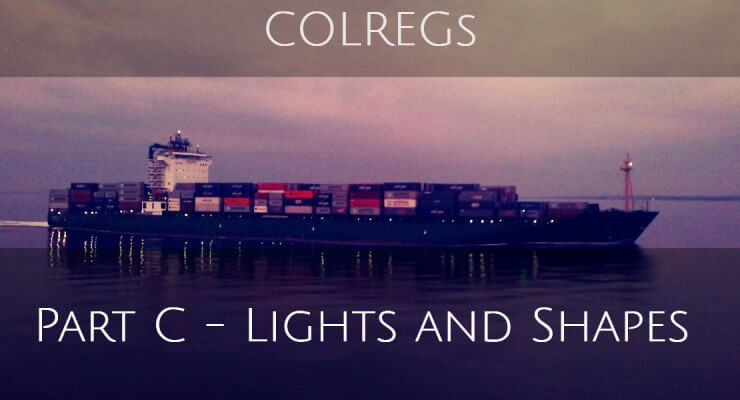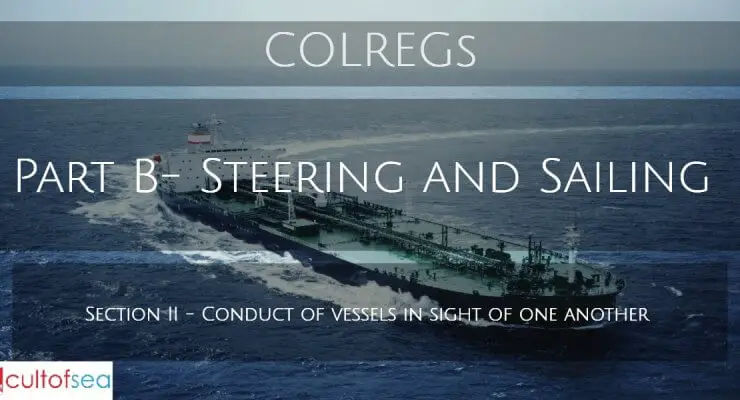The lights prescribed in these Rules shall have an intensity as specified in Section 8 of Annex I to these Regulations so as to be visible at the following minimum ranges:a. In vessels of 50 metres or more in length: a masthead light, 6 miles;a sidelight, 3 miles;a sternlight, 3 miles;a towing light, 3 miles;a white, red, green or yellow all-round light, 3 miles. b. In vessels of 12 metres or more in length but less than 50 metres in length:a masthead light, 5 miles; except that where the length of the vessel is less than 20 metres, 3 miles;a sidelight, 2 … [Read more...]
Rule 21- Definitions
Rule 21 Definitionsa. Masthead light means a white light placed over the fore-and-aft centerline of the vessel showing an unbroken light over an arc of the horizon of 225° and so fixed as to show the light from right ahead to 22.5° abaft the beam on either side of the vessel.b. Sidelights means a green light on the starboard side and a red light on the port side each showing an unbroken light over an arc of the horizon of 112.5° and so fixed as to show the light from right ahead to 22.5° abaft the beam on its respective side.In a vessel of less than 20 m in length the … [Read more...]
Rule 20 – Application
Rule 20 : Applicationa. Rules in this part shall be complied with in all weathers.b. The Rules concerning lights shall be complied with from sunset to sunrise, and during such times no other lights shall be exhibited, except such lights as cannot be mistaken for the lights specified in these Rules or do not impair their visibility or distinctive character, interfere with the keeping of a proper look-out. c. The lights prescribed by these Rules shall, if carried, also be exhibited from sunrise to sunset and in restricted visibility and may be exhibited in all other circumstances when … [Read more...]
Rule 19 – Conduct of vessels in restricted visibility
Section III – conduct of vessels in restricted visibility Rule 19: Conduct of vessels in restricted visibility a. This Rule applies to vessels not in sight of one another when navigating in or near an area of restricted visibility.Meaning that this Rule applies to such vessels that may be close to each other but cannot visually see each other, electronic devices and sound signals may be the only possible means of detection and thus the action that would be taken would not be visible by the other vessel. The areas are not only in areas of poor visibility but also areas near to that. … [Read more...]
Rule 18 – Responsibilities between vessels
Section II – Conduct of vessels in sight of one another Rule 18: Responsibilities between vessels Except where rule 9, 10, and 13 otherwise require:(a) A power-driven vessel underway shall keep out of the way of: (i) a vessel not under command; (ii) a vessel restricted in her ability to maneuver; (iii) a vessel engaged in fishing; (iv) a sailing vessel; Understanding, and complying with the Rules, the above are to be committed to memory and applied when meeting any of the named types of vessels. Except if the situation is within a TSS or a narrow channel or if an overtaking … [Read more...]
Rule 17 – Action by stand-on vessel
Section II – Conduct of vessels in sight of one another Rule 17: Action by stand-on vessel (a)(i) Where one of two vessels is to keep out of the way of the other shall keep her course and speed. Meaning: As long as the give way vessel takes an action well in time there is no problem and the stand on vessel follows the above Rule, and the stand on vessel is required not to take action, but it does not mean that she would not be alert and monitor the situation. (ii) The latter vessel may however take action to avoid collision by her manoeuvre alone, as soon as it becomes apparent to her that the … [Read more...]
Rule 16 – Action by give-way vessel
Section II – Conduct of vessels in sight of one another Rule 16: Action by give-way vessel Every vessel which is directed to keep out of the way of another vessel shall, so far as possible, take early and substantial action to keep well clear.Meaning: Give way vessels should take action well in time, estimate the speed of approach between the two vessels, estimate the approximate time interval and then take action, do not take a late action, since this would make the stand on vessel apprehensive and she may then take an action which would be detrimental to both vessels. … [Read more...]
Rule 15 – Crossing situation
Section II – Conduct of vessels in sight of one another Rule 15: Crossing situation When two power-driven vessels are crossing so as to involve risk of collision, the vessel which has the other on her own starboard side shall keep out of the way and shall, if the circumstances of the case admit avoid, crossing ahead of the other vessel. Meaning: This situation would frequently arise and it is always better to avoid a close quarter situation and go right around the stern of the other vessel rather than cross ahead of the other vessel. Of course going around the stern may not be practical at all … [Read more...]
Rule 14 – Head on situation
Section II – Conduct of vessels in sight of one another Rule 14: Head on situation a. When two power-driven vessels are meeting on reciprocal or nearly reciprocal courses so as to involve risk of collision each shall alter her course to starboard so that each shall pass on the port side of the other.Meaning: It is a clear instruction when the vessels are head on perfectly, the thing to remember is that when the vessels are nearly on reciprocal courses, then to the vessels are asked to alter course to starboard.A nearly reciprocal course would deem that the vessels would be passing … [Read more...]
Rule13 – Overtaking
Section II – Conduct of vessels in sight of one another Rule13 Overtaking a. Notwithstanding anything contained in the Rules of part B, sections I and II, any vessel overtaking any other shall keep out of the way of the vessel being overtaken.Meaning: It does not make a difference whether any ship ahead of the own vessel has permitted by signaling that overtaking may take place. As far as the Rules are concerned especially Rule 13, the overtaking vessel is duty bound to keep clear.b. A vessel shall be deemed to be overtaking when coming up with another vessel from a direction more … [Read more...]



